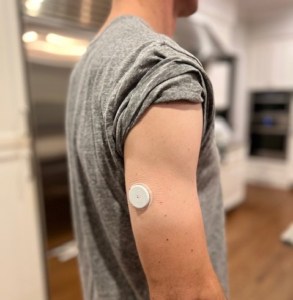
Have you been seeing more and more people wearing a little patch on the back of their arm? Chances are it’s a continuous glucose monitor, or CGM for short. These monitors are crucial for people with diabetes who need to monitor their blood glucose levels, but the easy to wear monitors are becoming more accessible, and popular, in the fitness crowd. Can wearing a CGM and monitoring your blood glucose levels help you lose weight? Should you try one too? Let’s dive in.
First let’s talk about what a CGM does. The patch has a flexible plastic catheter that measures glucose (sugar) in the soft tissue just under your skin that tracks closely with blood glucose levels. Through a bluetooth connection to your phone, you can monitor your glucose levels throughout the day to see how they respond to what you eat.
Normally, glucose levels will go up after eating and then will return to baseline within a few hours. If levels go too high or stay high for too long, that is not ideal. Additionally, sometimes after a meal, the glucose will overcorrect and drop lower than the starting point. This extra low dip can trigger hunger and lead to increased snacking. All these abnormal highs and lows of glucose are thought to contribute to inflammation, hormonal imbalances, excess hunger, weight gain, and can potentially lead to diabetes.
So what causes the glucose to go up? A high carbohydrate meal will increase blood sugar. A meal’s fiber, fat, and protein content can blunt the glucose response. The time of day you eat, exercise, gut bacterial populations, and genetics all impact blood glucose levels.
Does wearing a CGM really help you lose weight? Researchers are just beginning to study the effects of CGMs on health outcomes. Larger studies are needed, but there are numerous experiments showing that for people with diabetes, wearing a CGM leads to better food choices, increase in exercise, weight loss, and improvements in glucose readings. In one study, 100% of patients self-reported that their experience wearing the CGM led to healthier lifestyle habits.
For people without diabetes, this trend to wear a CGM is relatively new, but it is being looked at scientifically. Wyatt and colleagues did a study of over 1,000 non-diabetic subjects who wore CGMs. What they found is that the people who had significant dips in glucose 2-3 hours after a meal had increased appetite and consumed up to 300 more calories a day.
I think everyone can benefit from wearing a CGM for a few weeks to see how their body responds to food, however the data generated by the device can be confusing to interpret. That is why I also recommend working with a nutritionist at the same time. There are numerous companies like Zoe, Nutrisense, and others that can provide you with a CGM and a nutritionist to educate and guide you through the process. The goal is to keep your blood sugar in an optimal range without all the highs and lows. Once you see your own glucose trends, you can increase intake of fat, protein, fiber, decrease carbohydrates, or modify your exercise and meal timing to improve your glucose response.
Continuous glucose monitoring is personalized medicine at its finest. Once you see how your own glucose levels change with food and exercise, you can be empowered to make uniquely informed decisions that improve your health and longevity, and you just might lose weight while you are at it.
Dr. Bronwyn Fitz is double board-certified in Obstetrics and Gynecology and Integrative Medicine. If you want to learn more about her practice, click on Get Started to book a free 15-minute discovery call.
MW Porter et al, “592-P: Patient Perception of RT-CGM for Lifestyle Change Six Months after Two Session of RT-CGM” Diabetes 2021;70 (SupplementZ1):592-P
N Ehrhardt et al “Behavior Modification in Prediabetes and Diabetes:Potential Use of Real-Time Continuous Glucose Monitoring” J Diabetes Sci Technol. 2019 Mar; 13(2): 271-275
P Wyatt et al, “Postprandial glycaemic dips predict appetite and energy intake in healthy individuals,” Nature Metabolism 3, 523-529 (2021)
